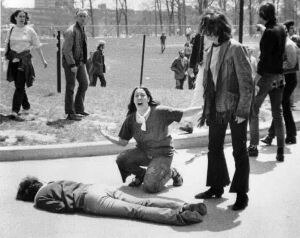| Revision as of 05:05, 23 September 2008 edit98.232.182.66 (talk) This is why the fencepost was doctored out← Previous edit | Revision as of 21:45, 24 September 2008 edit undoJivecat (talk | contribs)16,064 editsm punctuationNext edit → | ||
| Line 1: | Line 1: | ||
| ]'s iconic ]-winning photograph of Mary Ann Vecchio kneeling over the dead body of ] after he was shot by the National Guard.]]</div>'''Mary Ann Vecchio''' (born c. 1956) was the subject of a ]-winning photograph by ] student ] in the aftermath of the ] on ] ]. | ]'s iconic ]-winning photograph of Mary Ann Vecchio kneeling over the dead body of ] after he was shot by the National Guard.]]</div>'''Mary Ann Vecchio''' (born c. 1956) was the subject of a ]-winning photograph by ] student ] in the aftermath of the ] on ] ]. | ||
| The photograph shows the 14-year-old Vecchio kneeling over the body of ] who had been shot by the ] moments earlier. Vecchio had joined the protest while visiting the campus, where she had befriended two of the other students who were hit by gunfire that day |
The photograph shows the 14-year-old Vecchio kneeling over the body of ] who had been shot by the ] moments earlier. Vecchio had joined the protest while visiting the campus, where she had befriended two of the other students who were hit by gunfire that day: ], who was killed; and ], who was wounded. Other photographers also captured the scene from other angles. | ||
| A runaway from ] where she attended Westview Junior High School, Vecchio bartered her story after the shootings to a local reporter in exchange for a bus ticket to California. She was found by police before she boarded the bus, and sent back to her family, who reportedly later sued t-shirt companies for 40% of the profits of sales featuring Filo's photograph. Following Filo's publication of the photograph through the ''Tarentum Valley Daily News'' edition of the ], Florida governor ] labelled Vecchio a ] ].{{Fact|date=April 2008}} | A runaway from ] where she attended Westview Junior High School, Vecchio bartered her story after the shootings to a local reporter in exchange for a bus ticket to California. She was found by police before she boarded the bus, and sent back to her family, who reportedly later sued t-shirt companies for 40% of the profits of sales featuring Filo's photograph. Following Filo's publication of the photograph through the ''Tarentum Valley Daily News'' edition of the ], Florida governor ] labelled Vecchio a ] ].{{Fact|date=April 2008}} | ||
Revision as of 21:45, 24 September 2008

Mary Ann Vecchio (born c. 1956) was the subject of a Pulitzer Prize-winning photograph by photojournalism student John Filo in the aftermath of the Kent State shootings on May 4 1970.
The photograph shows the 14-year-old Vecchio kneeling over the body of Jeffrey Miller who had been shot by the Ohio National Guard moments earlier. Vecchio had joined the protest while visiting the campus, where she had befriended two of the other students who were hit by gunfire that day: Sandra Scheuer, who was killed; and Alan Canfora, who was wounded. Other photographers also captured the scene from other angles.
A runaway from Opa-locka, Florida where she attended Westview Junior High School, Vecchio bartered her story after the shootings to a local reporter in exchange for a bus ticket to California. She was found by police before she boarded the bus, and sent back to her family, who reportedly later sued t-shirt companies for 40% of the profits of sales featuring Filo's photograph. Following Filo's publication of the photograph through the Tarentum Valley Daily News edition of the Pittsburgh Tribune-Review, Florida governor Claude Kirk labelled Vecchio a dissident communist.
After Vecchio married Joe Gillum in 1979, the couple moved to Las Vegas, Nevada, where Vecchio became a clerk at a coffee shop.
In 1995, Vecchio met John Filo for the first time, when both were scheduled to appear at an Emerson College conference commemorating the 25th anniversary of the shootings. She also appeared at Kent State University in May of the same year, for the 25th annual commemoration. She returned to Kent State University again for the 36th commemoration in May 2006, and for the 37th commemoration in May 2007.
Vecchio has been portrayed in several stage performances about the Kent State shootings. The character Vekeero in Halim El-Dabh's 1971 Opera Flies is based on Vecchio. Her role was played by Kelley Lepsik in the 2000 performance of Kent State: A Requiem.
When published, the photograph was retouched to remove the distracting fencepost over Vecchio's head in the original image. The unretouched original was stored in the archives of Life magazine.
References
- Brozan, Nadine (1995-04-25). "Chronicle" (hosted at May4Archive.org). The New York Times. p. B4. Retrieved 2007-05-01.
{{cite news}}: Check date values in:|date=(help) - Kent May 4 Center
- "Ethics". Michigan Press Photographers Association. Archived from the original on 2003-08-13. Retrieved 2007-05-01.